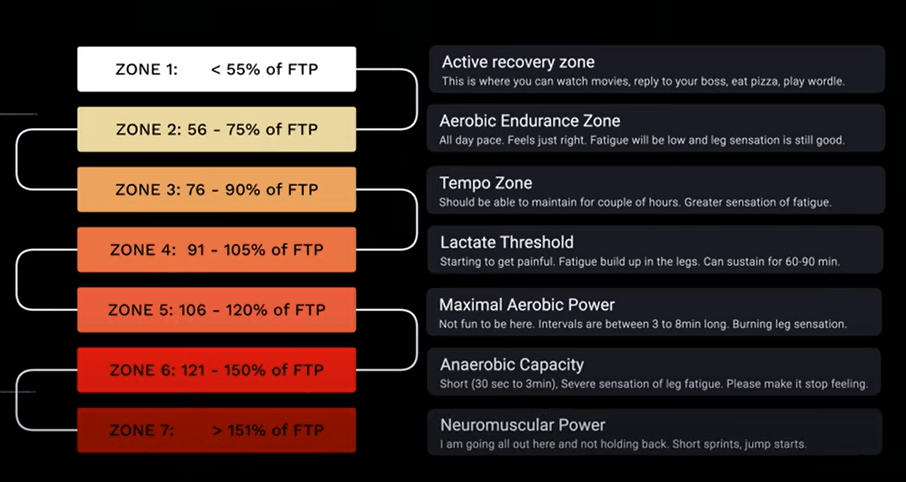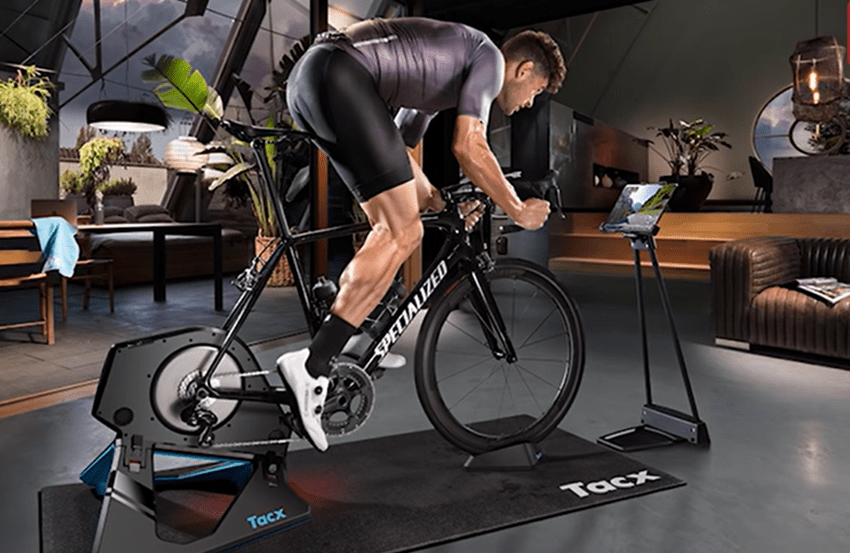Contents
- 1 MASTERING CYCLING POWER ZONES
The revolution of power-based training
- 1.1 The advantages of power measurement over traditional methods are clear and measurable:
- 1.2 Why power zones matter more than ever
- 1.3 What You’ll Learn
- 1.4 Part 1: Power Zone Foundations
- 1.5 Part 2: The Power Zone System
- 1.6 Part 3: Training Plans
- 1.7 Part 4: Essential Tools
- 1.8 Part 5: Troubleshooting
- 1.9 Conclusion
- 1.10 Bonus Resources
MASTERING CYCLING POWER ZONES
 The revolution of power-based training
The revolution of power-based training
Cycling power zones training and cycling performance monitoring have fundamentally changed how cyclists approach their sport since the 1990s, when SRM introduced the first cycling power meter. Before this breakthrough in power meter basics, cyclists relied on subjective feelings and heart rate – both valuable, but imperfect measures. The shift to measuring watts cycling and actual power output brought unprecedented precision to structured training, similar to how a runner might use a GPS watch for precise pacing.
The advantages of power measurement over traditional methods are clear and measurable:
Instantaneous feedback on effort changes (unlike heart rate’s 30-60 second lag)
Consistent metrics across weather conditions
Precise interval targeting within specific power zones
Ability to track long-term progress objectively
Professional cycling teams quickly demonstrated the effectiveness of power-based training. Team Sky (now INEOS) notably used power data to optimize their training and racing strategies, contributing to multiple Tour de France victories. This systematic approach has now become standard practice from the professional peloton to local racing scenes.
Why power zones matter more than ever
In today’s data-driven cycling world, power zones have become essential tools for efficient training progression. While cyclists once relied solely on generic time-based workouts, power zones now provide a precise framework for targeting specific physiological adaptations.
This precision matters because research shows that monitoring training stress balance and spending the right amount of time in each zone – particularly the crucial sweet spot training range between tempo rides and threshold power – leads to greater fitness gains with less fatigue. Modern training peaks and cycling computers offer:
Competitive Cyclist Black Friday Sprint Up to 50% Off
Real-time zone adjustments based on FTP
Specific power targets for each interval
Clear visual feedback during workouts
Progressive overload calculations
The rise of indoor cycling with smart trainers has further amplified the importance of power zone training, allowing cyclists to hit exact power targets regardless of terrain or weather conditions.
What You’ll Learn
This comprehensive guide will walk you through the science and application of power zone training – from understanding your baseline numbers to mastering advanced interval techniques. You’ll discover how to accurately determine your functional threshold power (FTP) and calculate your personal training zones, removing the guesswork from your training schedule.
We’ll explore each power zone in detail, showing you exactly how and when to train in different intensities for maximum benefit. Whether you’re looking to build endurance, boost threshold power, or improve sprint capabilities, you’ll learn precisely how to structure your workouts for optimal results.
Part 1: Power Zone Foundations
Understanding Power Zones
What Are Power Zones?
Cycling power zones divide your riding intensity into distinct levels based on your Functional Threshold Power (FTP). Think of these zones as gears in your training engine – each one serves a specific purpose in developing your cycling fitness.
Experience pro-level indoor cycling for less: Wahoo KICKR Core delivers whisper-quiet, accurate resistance training with seamless app connectivity.
When you train with cycling power zones, you’re working with percentages of your FTP, which provides precise targets for every workout. Unlike subjective measures of effort, power zones give you exact numbers to hit, typically measured in watts, making it easier to track progress and ensure you’re training at the right intensity for your goals.
The 7 Power Zones Explained
Cycling power zones are organized into seven distinct levels, each targeting specific physiological adaptations. Zone 1 (Active Recovery) ranges from 0-55% of FTP, perfect for easy spins and recovery rides. Zone 2 (Endurance) at 56-75% of FTP builds your aerobic base. Zone 3 (Tempo) operates at 76-87% of FTP, ideal for sustained efforts. Zone 4 (Threshold) at 88-100% of FTP represents your highest sustainable power. Zone 5 (VO2 Max) pushes to 101-120% of FTP for short, intense efforts.
Zone 6 (Anaerobic) at 121-150% of FTP develops explosive power. Zone 7 (Neuromuscular) exceeds 150% of FTP for maximum power output. Each zone serves a specific purpose in your training plan and contributes to overall cycling performance.
Power Zones vs. Heart Rate Zones
While both systems measure intensity, cycling power zones offer immediate feedback compared to heart rate’s delayed response. Power zones remain consistent regardless of factors like fatigue, temperature, or stress – factors that can significantly affect heart rate zones.
For example, when you jump into a hard effort, your power meter instantly shows your zone, while heart rate might take minutes to reflect the intensity. Additionally, cycling power zones provide more precise training targets because they measure your actual output rather than your body’s response to that output.
However, using both systems together can provide valuable insights – power zones for immediate intensity guidance and heart rate for understanding your body’s response to that effort.
Your Power Profile
Finding Your FTP
Establishing your Functional Threshold Power (FTP) is the cornerstone of training with cycling power zones. The most common method is the 20-minute FTP test: after a thorough warm-up, ride as hard as you can maintain for 20 minutes. Take 95% of your average power from this effort to estimate your FTP.
For greater accuracy, some cyclists prefer the ramp test, where power increases gradually until exhaustion. Alternatively, you can determine your FTP through a traditional hour-long effort, though this is more demanding. Whichever method you choose, test in similar conditions each time – this ensures consistent baselines for your cycling power zones and accurate training targets.
Calculating Your Zones
Once you know your FTP, establishing your cycling power zones becomes straightforward mathematics. Start by writing down your FTP number – let’s say it’s 200 watts. Zone 1 (Active Recovery) is 0-55% of FTP or 0-110 watts. Zone 2 (Endurance) is 56-75% or 111-150 watts. Zone 3 (Tempo) spans 76-87% or 151-174 watts. Zone 4 (Threshold) covers 88-100% or 175-200 watts. Zone 5 (VO2 Max) ranges from 101-120% or 201-240 watts. Zone 6 (Anaerobic) encompasses 121-150% or 241-300 watts. Zone 7 (Neuromuscular) includes anything above 150% or 300+ watts.
Power Zone Calculator Tool
Modern cycling computers and training apps simplify the process of working with cycling power zones through built-in calculators. These tools automatically update your zones when you input a new FTP, and many offer visual representations of your time spent in each zone during workouts. Apps like TrainingPeaks, Zwift, and TrainerRoad include power zone calculators that integrate directly with your training plan.
For those preferring a manual approach, spreadsheet-based calculators can track your zones over time, allowing you to monitor long-term progress. Remember to recalculate your zones every 4-6 weeks as your fitness changes to ensure your training stays properly targeted.
Part 2: The Power Zone System
Zone 1: Active Recovery
When to Use
Cycling power zones place Zone 1 (0-55% of FTP) as your primary recovery tool. Use this zone between hard training days, after intense races, or during the cool-down portion of challenging workouts. A power meter ensures you’re truly staying in this easy zone – a common mistake is riding too hard during what should be recovery. By watching your power numbers, you’ll maintain the discipline needed to keep intensity low enough for proper recovery.
Benefits
Training in the lowest of the cycling power zones promotes active recovery while maintaining movement patterns. Zone 1 increases blood flow to tired muscles without creating additional fatigue, helps remove metabolic waste, and allows your body to adapt to previous training stress. This zone also provides mental recovery, letting you enjoy easy rides while maintaining your training routine.
Example Workouts
Zone 1 cycling power zones workouts should be simple and stress-free. A basic 30-60 minute ride maintaining power below 55% of your FTP is ideal. Another effective workout is a “spin-out” session: 45 minutes at Zone 1 power with three 30-second high-cadence (100+ rpm) segments at the same low power, helping maintain muscle activation without adding stress.
Recovery Techniques
While riding in cycling power zones at recovery intensity, focus on proper recovery techniques to maximize benefits. Maintain a higher than normal cadence (90-95 rpm) to reduce muscular strain. Stay well-hydrated and fuel appropriately with easily digestible carbohydrates. Include 5-10 minute blocks of slightly higher power (still within Zone 1) to promote blood flow without adding fatigue.
Zone 2: Endurance
Building Your Base
Zone 2 of cycling power zones (56-75% of FTP) forms the foundation of your endurance training. This moderate intensity builds aerobic capacity while remaining sustainable for long periods. Focus on accumulating time in this zone – aim for 2-3 rides per week ranging from 90 minutes to 4 hours, depending on your experience level. This consistent, low-intensity work develops mitochondrial density and fat-burning efficiency, essential adaptations for endurance cycling.
Long Ride Strategies
Managing cycling power zones during extended rides requires strategic pacing. Start your long rides at the lower end of Zone 2, allowing room to naturally drift up within the zone as fatigue sets in. Break long rides into manageable segments – 30-minute blocks at steady Zone 2 power, with brief periods at the low end for fueling. On hills, focus on maintaining consistent effort rather than speed, using your power meter to prevent pushing too hard.
Nutrition Needs
Fueling properly for Zone 2 cycling power zones training is crucial for endurance development. Aim to consume 40-60 grams of carbohydrates per hour, even though the intensity feels easy. Start eating within the first 30 minutes and drink regularly, targeting 500-750ml of fluid per hour. Keep protein intake minimal during rides but include it in your post-ride recovery meal.
Common Mistakes
The biggest pitfall in Zone 2 cycling power zones training is riding too hard. Many cyclists push into Zone 3 unknowingly, especially when feeling fresh or riding with groups. Another common error is skipping fueling due to the lower intensity. Remember: these rides build endurance through duration, not intensity. Use your power meter religiously to stay within the zone, even if it feels too easy.
“Fuel your ride with top-rated cycling nutrition – boost energy, endurance, and recovery!”
Zone 3: Tempo
Sweet Spot Training
Within cycling power zones, Tempo (76-87% of FTP) includes the crucial “sweet spot” range, typically 84-87% of FTP. This intensity balances training stress and recovery, allowing for significant aerobic gains without excessive fatigue. Sweet spot work in your cycling power zones creates enough stress to drive adaptation while remaining sustainable for longer intervals, making it highly time-efficient for building fitness.
Building Stamina
Zone 3 cycling power zones training develops muscular endurance and metabolic efficiency. These efforts push your body to process lactate more effectively while improving your ability to sustain higher power outputs. Regular tempo work increases your fatigue resistance, particularly valuable for time trials, climbing, and maintaining position in fast group rides.
Key Workouts
Essential tempo workouts in cycling power zones include 2×20 minutes at 85% FTP with 5 minutes recovery, or 3×15 minutes at 82-85% FTP with 3-minute breaks. For a progressive approach, start with 10-minute intervals and gradually increase duration. More advanced riders can try “progressive tempo” where power increases from low Zone 3 to sweet spot over 30 minutes.
When to Use
Include Zone 3 cycling power zones work 2-3 times per week during base and build phases. These sessions are ideal for time-crunched cyclists, offering substantial training benefit in 60-90 minutes. Schedule tempo rides between recovery days and harder interval sessions. Reduce or eliminate tempo work during peak race preparation and recovery weeks to maintain freshness.
Zone 4: Threshold
FTP Development
Zone 4 in cycling power zones (88-100% of FTP) targets your threshold power directly, representing the highest intensity you can sustain for approximately one hour. Training in this zone improves your body’s ability to process lactate and maintain high power outputs. Structure your FTP development with progressive overload – start with shorter intervals at threshold power, gradually increasing duration as your fitness improves.
Key Intervals
Effective threshold intervals in cycling power zones typically range from 5 to 20 minutes. Start with 3×8 minutes at 90-95% FTP with 4-minute recoveries, progressing to 2×20 minutes at 88-92% FTP with 8-minute recoveries. The classic “2×20” threshold workout remains a staple for developing FTP. Advanced riders can attempt 30-minute continuous efforts just below FTP, closely monitoring power to prevent fade.
Mental Strategies
Success in Zone 4 cycling power zones requires strong mental focus. Break intervals into smaller segments – think of a 20-minute effort as four 5-minute blocks. Watch your power numbers closely during the first third of each interval to avoid going too hard too soon. Use positive self-talk and focus on maintaining smooth pedaling when fatigue builds. Remember: threshold intervals should feel challenging but sustainable.
Recovery Needs
Zone 4 cycling power zones work creates significant training stress, demanding adequate recovery. Limit threshold sessions to 2-3 times per week, always separated by at least one easy day. After threshold workouts, prioritize protein intake within 30 minutes and ensure 8-9 hours of sleep. Consider reducing intensity or volume if you can’t maintain target power in subsequent workouts, indicating incomplete recovery.
Zone 5: VO2 Max
High-Intensity Work
Zone 5 in cycling power zones (101-120% of FTP) targets your VO2 max, the maximum rate at which your body can utilize oxygen during exercise. These efforts typically last 3-8 minutes, pushing your cardiovascular system to its limit. Training in this zone increases your body’s oxygen uptake capacity and power at VO2 max, crucial for breaking away or responding to attacks in races.
Race Preparation
Incorporating Zone 5 cycling power zones work is essential for race readiness. Begin including these intervals 8-12 weeks before your target event. Start with one session per week, potentially increasing to two during peak training blocks. These efforts mirror the intense demands of racing, preparing you for decisive moments when races are won and lost.
Interval Structure
Classic VO2 max intervals in cycling power zones include 4-6 repetitions of 3-minute efforts at 110-120% FTP with equal recovery periods. Another effective format is 5×4 minutes at 105-110% FTP with 4-minute recoveries. For more advanced riders, try progressive intervals: 3×5 minutes starting at 105% FTP and increasing power every minute.
Recovery Requirements
Zone 5 cycling power zones training creates substantial stress, requiring careful recovery management. Allow at least 48 hours between VO2 max sessions and limit them to 1-2 times per week. Active recovery rides and proper nutrition become crucial – consume 20-25g of protein post-workout and ensure adequate carbohydrate replenishment. Monitor your resting heart rate and power output in subsequent workouts for signs of incomplete recovery.
Zone 6: Anaerobic
Sprint Power
Within cycling power zones, Zone 6 (121-150% of FTP) develops explosive power and anaerobic capacity. These efforts typically last 30 seconds to 2 minutes, targeting your body’s ability to produce energy without oxygen. Training in this zone improves your ability to generate high power outputs repeatedly – crucial for sprints, attacks, and short climbs. Power output here should feel explosive and unsustainable beyond the prescribed duration.
Short Intervals
Zone 6 cycling power zones intervals are brief but intense. Standard workouts include 6-8 repetitions of 30-second efforts at 130-150% FTP with 2-3 minutes recovery, or 4-6 sets of 1-minute efforts at 125-135% FTP with 3-minute recoveries. Start these intervals from moderate speed to prevent neuromuscular fatigue and maintain proper form throughout each effort.
“Master the pro peloton’s winning moves: Race-tested cycling strategies that transform good riders into champions.”
Race Tactics
Applying Zone 6 cycling power zones effectively in races requires tactical awareness. Use these explosive efforts for bridging gaps, initiating breakaways, or responding to attacks. Practice transitioning from Zone 3 or 4 directly into Zone 6 efforts, mimicking race scenarios. The ability to recover quickly from these efforts while maintaining race pace often determines success in competitive situations.
Recovery Protocols
Recovery from Zone 6 cycling power zones work demands attention to detail. Limit these sessions to once or twice per week, never on consecutive days. Active recovery between intervals is crucial – keep spinning at 50-55% FTP. Post-workout, focus on glycogen replenishment with 60-80g of carbohydrates and 20g of protein within 30 minutes. Allow 48-72 hours before another high-intensity session.
Zone 7: Neuromuscular
Maximum Power
Zone 7 represents the highest of all cycling power zones, exceeding 150% of your FTP. These all-out efforts typically last 5-15 seconds, targeting pure speed and maximum power production. Training in this zone develops neuromuscular coordination and fast-twitch muscle fiber recruitment. For reference, elite sprinters can produce power outputs over 1500 watts in this zone, though any effort above 150% of your FTP counts as Zone 7 work.
Sprint Training
Developing Zone 7 cycling power zones requires specific sprint training. Structure workouts with 4-6 maximum sprints of 10-15 seconds, allowing 5-10 minutes of recovery between efforts. Start with a rolling speed of 18-20 mph before each sprint. Focus on both seated and standing sprints, practicing smooth transitions between positions. Maintain perfect form – any sprint with deteriorating technique should be your last for that session.
Race Applications
Zone 7 cycling power zones come into play during crucial race moments – primarily finish-line sprints and immediate responses to attacks. Practice sprinting from different positions: front, second wheel, and from further back. Include race-specific scenarios in training, such as sprinting after a period of sustained high power, or multiple sprints with short recoveries to mimic dynamic race finishes.
Safety Considerations
When training in maximal cycling power zones, safety becomes paramount. Always perform a thorough 20-minute warm-up before any Zone 7 efforts. Choose locations with good road surfaces and clear sightlines. Never attempt maximum sprints while fatigued or in poor weather conditions. Monitor your bike’s structural integrity regularly, as these efforts place extreme stress on your equipment. Limit Zone 7 training to once or twice per week maximum, with at least 48 hours between sessions.
Part 3: Training Plans
Beginner Power Zone Plan
8-Week Structure
The beginner approach to cycling power zones follows a progressive structure. Weeks 1-2 focus on understanding zone adherence, spending most time in Zones 1-2. Weeks 3-4 introduce Zone 3 tempo work. Weeks 5-6 add structured Zone 4 threshold intervals. Weeks 7-8 incorporate brief exposures to Zones 5-6. This gradual progression allows your body to adapt while building confidence in using cycling power zones effectively.
Key Workouts
Essential beginner workouts in cycling power zones start simple and progress gradually. Early weeks feature 2×15 minutes in Zone 2 with Zone 1 recovery. Mid-program introduces 2×10 minutes Zone 3 sweet spot efforts. Later weeks add 2×8 minutes of Zone 4 work. A typical week includes two structured workouts and one longer Zone 2 ride. Recovery sessions in Zone 1 fill the remaining days. Each workout should feel challenging but achievable.
“Transform every ride into progress: Track your cycling journey with this detailed 102-page training log – your roadmap to becoming a stronger rider.”
Progress Tracking
Monitor your development in cycling power zones through key metrics. Record your average power for set-duration efforts (5min, 20min) every two weeks. Track time spent in each zone using your head unit or training software.
Note rate of perceived exertion (RPE) alongside power numbers to understand how your perception aligns with output. Take screenshots of key workouts and maintain a simple log of weekly training stress scores (TSS). Consider retesting FTP every 4-6 weeks to ensure your zones remain accurate.
Intermediate Power Zone Plan
12-Week Progression
Intermediate cycling power zones training builds across three 4-week blocks. Block 1 establishes base fitness with substantial Zone 2/3 work. Block 2 increases threshold training in Zone 4 with introductions to Zone 5. Block 3 peaks intensity with structured Zone 5/6 intervals while maintaining threshold power. Each block includes a recovery week where volume drops by 40% but intensity remains. This structured progression prevents plateaus while systematically building fitness.
Advanced Intervals
Intermediate cyclists ready for more complex cycling power zones work tackle progressive intervals: 30/30s (30 seconds Zone 5, 30 seconds Zone 3), over-unders (alternating between Zones 4 and 5), and pyramid sets (ascending and descending through zones). Key sessions include 3×12 minutes sweet spot with 30-second Zone 6 surges, and 4×8 minutes threshold with Zone 5 finishes. These combinations improve your ability to change pace while maintaining power.
Periodization
Structure your cycling power zones training using traditional periodization principles. Build weeks progressively increase training load through volume or intensity, never both simultaneously. Include recovery weeks every fourth week, reducing volume but maintaining high-intensity exposures. Alternate focus between threshold power (Zone 4) and VO2 max development (Zone 5) every two weeks. This systematic approach optimizes adaptation while preventing burnout.
Performance Metrics
Track progress in cycling power zones through multiple metrics. Monitor normalized power for steady-state efforts and maximum 1-minute, 5-minute, and 20-minute power outputs. Record intensity factor (IF) and training stress score (TSS) for each workout. Compare power duration curves month-to-month. Track time in zones weekly, aiming for approximately 80% of time in Zones 1-3 and 20% in Zones 4-7. Regular FTP testing confirms zone accuracy and progression.
Advanced Power Zone Plan
Race Preparation
Advanced cycling power zones training demands precise periodization leading to key events. Structure your final 8 weeks with decreasing volume and increasing intensity. Include race-specific intervals: 3×8 minutes at Zone 5 (105-120% FTP) with Zone 6 surges, mimicking attack scenarios. Incorporate group rides strategically, using them to practice position-dependent power outputs. Weekly training should include two high-intensity sessions, one race-simulation workout, and targeted endurance rides.
Peak Power
Maximizing peak power within cycling power zones requires structured overload periods. Focus on specific power targets: 5-second power (Zone 7), 1-minute power (Zone 6), and 5-minute power (Zone 5). Key workouts include sprint pyramids (increasing duration, decreasing intensity) and capacity intervals (30/30s at Zone 6/Zone 2). Monitor power numbers closely, looking for 2-3% improvements in targeted durations during your peak phase.
Tapering
Tapering in cycling power zones preserves fitness while building freshness. Reduce training volume by 40-50% over 7-10 days pre-race, but maintain intensity in short bursts. Keep one Zone 5 session 4-5 days out, limiting intervals to 2-3 minutes. Decrease Zone 2 duration but include daily activation with Zone 4 bursts of 1-2 minutes. Track normalized power during taper workouts to ensure intensity remains while volume drops.
Race Day Strategy
Apply your cycling power zones knowledge strategically during races. Warm up progressively through Zones 1-4, including 2-3 Zone 5 efforts. During the race, spend most time in Zone 3, using Zones 5-6 only for critical moves. Save Zone 7 efforts for finish or decisive moments. Monitor normalized power throughout to prevent burnout. Use power data to pace climbs effectively, preventing critical power spikes that could cause premature fatigue.
“Choose your perfect power meter: Track every watt with confidence, any way you want to ride.”
Part 4: Essential Tools
Power Meters
Types Available
Training with cycling power zones requires choosing between several power meter types. Pedal-based systems offer easy transfer between bikes and dual-leg power measurement. Crank-based meters provide consistent readings and better weatherproofing. Spider-based power meters offer good accuracy at mid-range prices. Hub-based systems work well for dedicated training wheels. Single-sided options (measuring one leg and doubling the value) provide a budget-friendly entry into cycling power zones training.
Price Ranges
Power meters for cycling power zones training span wide price ranges. Entry-level, single-sided crank options start around $300-400. Mid-range pedal-based systems and dual-sided crank options cost $600-900. Premium dual-sided pedal systems range from $900-1,200. Spider-based power meters typically fall between $500-800. Hub-based systems cost $600-1,000. Consider future upgrades and compatibility when choosing your price point – accuracy and reliability generally improve with investment.
Best Choices
For optimal cycling power zones training, several power meters stand out. The Favero Assioma Duo pedals ($650) offer excellent accuracy and reliability at a mid-range price. 4iiii’s Precision crank ($300-600) provides a solid single or dual-sided option. Garmin Rally pedals ($1,000-1,200) excel in durability and multi-platform compatibility. Power2Max spider meters ($600-800) balance accuracy with value. For beginners, the single-sided 4iiii Precision ($300) or Stages crank ($350) offer reliable entry points into power-based training.
Training Apps
Zone Training Tools
Modern apps streamline cycling power zones training through intuitive interfaces. TrainerRoad, Zwift, and TrainingPeaks automatically calculate and display your zones after FTP input. These platforms provide real-time zone feedback during workouts through color-coding and alerts. Wahoo SYSTM offers comprehensive power zone testing protocols and customizable zone ranges.
Each app includes specific workouts designed around power zones, making it easier to target the right training intensity.
Workout Builders
Creating structured cycling power zones workouts becomes straightforward with app-based builders. TrainingPeaks’ Workout Creator lets you design intervals using drag-and-drop zones. Zwift’s Custom Workout feature enables power-based interval creation with specific zone targets. TrainerRoad’s Workout Creator allows fine-tuning of intensity and duration within each zone. These tools include pre-made workout libraries specifically designed around power zone training principles.
Progress Tracking
Apps monitor your cycling power zones progress through various metrics. TrainingPeaks tracks time-in-zones, training stress scores (TSS), and intensity factors (IF). Strava’s power curve shows improvements across different durations. Intervals.icu provides detailed zone distribution analysis and fitness tracking. These platforms automatically flag new power records and track long-term trends in each zone, helping identify strengths and weaknesses.
Data Analysis
Advanced cycling power zones analysis becomes accessible through training apps. WKO5 offers deep power duration curves and time-in-zone distribution charts. Golden Cheetah provides free, detailed power analysis including quadrant analysis and critical power calculations.
TrainingPeaks’ Performance Management Chart tracks fitness, fatigue, and form through power data. These tools help optimize training by identifying patterns and areas needing attention.
Part 5: Troubleshooting
Common Challenges
Most cyclists face initial hurdles when adapting to cycling power zones training. Typical issues include difficulty maintaining steady power on varied terrain, overshooting zone targets due to enthusiasm, and struggling with power spikes during group rides. Indoor versus outdoor power numbers may vary by 2-5%. Solutions include practicing smooth power delivery, using 3-second average power display, and accepting that real-world conditions require some power fluctuation within zones.
Zone Adjustments
Cycling power zones require regular fine-tuning as fitness changes. Watch for signs that zones need updating: consistently high or low perceived exertion compared to zone targets, inability to complete prescribed intervals, or feeling unchallenged by previous benchmarks. Consider adjusting individual zones rather than entire FTP if certain ranges feel misaligned. Some athletes perform better with modified zone ranges – particularly in Zone 2 and sweet spot training.
Fatigue Management
Monitoring fatigue while training with cycling power zones requires attention to key indicators. Watch for declining power outputs at given heart rates, inability to reach previous power targets, or unusual perceived exertion levels. Track morning resting heart rate and power output in Zone 2 rides. If power drops more than 5% in steady-state efforts, consider additional recovery. Adjust training load by reducing volume before reducing intensity.
Progress Plateaus
When advancement in cycling power zones stalls, systematic analysis helps identify causes. Review training load distribution – ensure you’re not spending too much time in moderate intensity zones (Zone 3 trap). Examine recovery quality, including sleep and nutrition. Consider changing stimulus by adjusting interval formats while maintaining zone targets. Sometimes plateaus indicate the need for a recovery block – reduce volume by 40% for one week while maintaining brief high-intensity exposures.
Conclusion
Action Steps
Begin your cycling power zones journey with clear, progressive steps. First, establish your FTP through a structured test and calculate your zones. Start with three focused workouts weekly: one endurance ride (Zone 2), one tempo session (Zone 3), and one threshold workout (Zone 4). Track your time-in-zones using a cycling computer or training app.
Test your FTP every six weeks, adjusting zones accordingly. Maintain a training log documenting power outputs, perceived effort, and recovery quality. This systematic approach ensures steady progress while building confidence in power-based training.
Next Level Training
Advanced cycling power zones training introduces sophisticated concepts and methods. Progress to polarized training, spending 80% of time in Zones 1-2 and 20% in Zones 5-7, minimizing Zone 3. Experiment with micro-bursts (15/15s between Zones 6 and 2), progressive sweet spot blocks, and race-specific interval patterns.
Consider working with a power-based coach to optimize your training plan. Explore advanced metrics like Power Duration Curves, Quadrant Analysis, and Training Stress Balance. Remember that advanced training requires increased attention to recovery and periodization to prevent overtraining while maximizing adaptation.
Bonus Resources
Zone Calculators & Analysis (Free):
ntervals.icu
• Most comprehensive free option
• Automatic sync with Strava
• Detailed power curve analysis
• Custom zone calculator with multiple models (Classic, Coggan, Custom)
• Heat maps showing your training distribution
• No premium subscription needed
Training Peaks Basic (Free Version)
• Basic zone calculator
• Simple workout tracking
• PMC chart (Performance Management Chart)
• Limited to 7-day data view in free version
Golden Cheetah (Free Software)
• Downloadable software for Windows/Mac
• Advanced power analysis
• Custom charts and metrics
• Steep learning curve but powerful
• Complete power zone analysis
Paid Training Platforms with Zone Features:
TrainerRoad ($19.99/month)
Full training plan builder
Adaptive Training feature
Power zone-based workouts
Regular FTP testing protocols
AI-powered workout suggestions
Zwift ($14.99/month)
Interactive training environment
Built-in FTP tests
Power zone-based workouts
Custom workout creator
Group rides based on power zones
TrainingPeaks Premium ($19.99/month)
Advanced analytics
Custom workout builder
Power zone distribution charts
Annual training plan creator
Coach connection features
If you enjoyed learning about this week’s featured bicycle, don’t miss out on more classic bike goodness! Visit our website at classicjapanesebicycles.com for an extensive collection of timeless Japanese bikes and their unique stories. Plus, check out our YouTube channel, Bicycle Restoration Man, for detailed restoration videos and showcases of our finished projects. Subscribe and join our community of bike enthusiasts!
 |
 |
We earn from qualified Amazon purchases with NO cost to you. ANY item that you need or were going to purchased anyway through any of our links, helps support this site. Thank you for your support!











